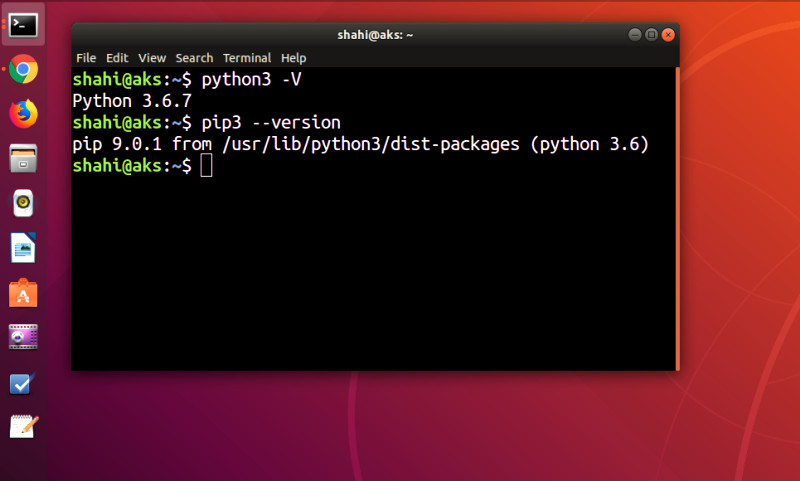

- #DOWNLOAD PYTHON 3 INSTALL FOR UBUNTU HOW TO#
- #DOWNLOAD PYTHON 3 INSTALL FOR UBUNTU UPDATE#
- #DOWNLOAD PYTHON 3 INSTALL FOR UBUNTU UPGRADE#
Python 3 comes already installed with Ubuntu 18.04 and it's very easy to update it to latest once there is a need.
#DOWNLOAD PYTHON 3 INSTALL FOR UBUNTU HOW TO#
How to Install Golang 1.8 on Debian 9 Stretch.You'll see the output: I am new to Python! Now every time you run your application with this command: python my_first_app.py py extension via your favorite text editor and give it a name: vim my_first_app.pyĪdd the following text in the file and save it: print("I am new to Python!") To do so, change your working directory to environments folder and run the command to activate the desired environment: cd ~/environments source my_first_env/bin/activateĬreate a file with. First of all we need to activate the environment or, if you want, enter inside the virtual environment. Our application will output "I am new to Python!" every time we run it. (my_first_env) leave the environment just type the command below: deactivate How to create simple python application within the virtual environmentĪfter virtual environment is created we can create a simple application inside it and test if it works. To be able to use the newly created environment you must run:Īfter activating the environment you must see the environment name in brackets in front of your prefix. The output must look like the one below: bin include lib lib64 pyvenv.cfg share To do so, run: mkdir environments & cd environmentsĬreate a virtual environment and give it a name which will best describe the environment purpose: python3 -m venv my_first_envĪctually, the command above create a directory with needed files. Install python3 virtual environment package by running the command below: sudo apt install -y python3-venvĬreate folder for environments and change your working directory to it. Once all prerequisites are installed you can proceed to virtual environment creation.

To install them all, run: sudo apt-get install build-essential libssl-dev libffi-dev python-dev Once pip is installed you can run the following command to install python packages: pip3 install īesides pip you need some more packages that need to be installed as prerequisites. If pip isn't installed on your machine, run the following command to install it: sudo apt install python3-pip Output must look like the one below: pip 9.0.1 from /usr/lib/python3/dist-packages (python 3.6) If you installed python from source, pip is being installed along with python. Outside of an environment, you must use python3 and pip3 commands for running Python 3.įollowing the steps below you can setup a virtual environment for python3 and use it to develop applications.įirst of all you need to check if pip (python package manager) installed along with your python installation. Virtual environment for python is an isolated space on your computer for Python projects, which allows each of your projects to have its own set of dependencies and don't disturb any other project. Inside the virtual environment, you can use python and pip commands instead of python3 and pip3 accordingly. How to setup virtual environment for python3 Once all files are removed you can proceed to the installation of newer version. To do so you can run the following commands: sudo rm /usr/local/bin/py* As this method if installation locates python files in /usr/local/bin path, you must remove python files from that path. If you have installed python from source and need to update it, you must uninstall the previous one and repeat the installation steps which are described above in this article. Note that you cannot mention major python3 version as it is being used by the system, but you can uninstall minor version which is preinstalled on your machine. To uninstall python from your Ubuntu 18 machine, run: sudo apt remove python3.6 The steps of how to do so are described in the section below. Or if you have installed manually from source, you must uninstall the previous version and install the latest version or the one you want.
#DOWNLOAD PYTHON 3 INSTALL FOR UBUNTU UPGRADE#
To update python to the latest version, you can run: sudo apt-get upgrade python3 Output must look like this: Python 3.6.5rc1 How to update python to latest version

After installation is completed check the installed version with the following command: python3.6 -V To install the missing package run: sudo apt install zlib1g-devĪfter package installation run the sudo make and sudo make install commands once more. Makefile:1099: recipe for target 'install' failed However, if there wasn't need to use zlib1g-dev package before, you'll get an error of it's absence, which will look like this: zipimport.ZipImportError: can't decompress data zlib not available Once the check has been completed run the following commands in the mentioned order to install python 3.6.5 sudo make sudo make install Change your directory to the newly created Python3.6.5 folder by running: cd Python-3.6.5Īnd run the configure script to check the build.


 0 kommentar(er)
0 kommentar(er)
